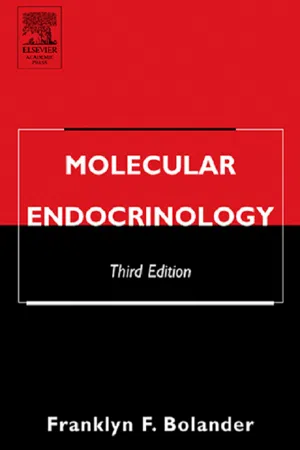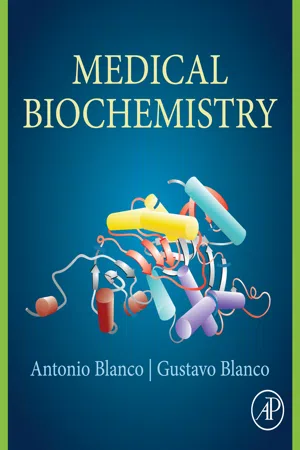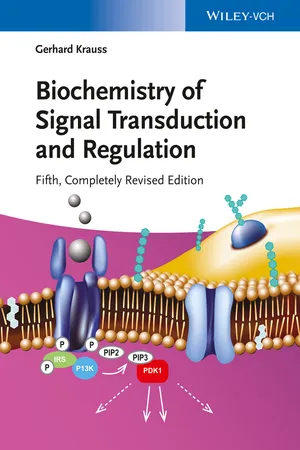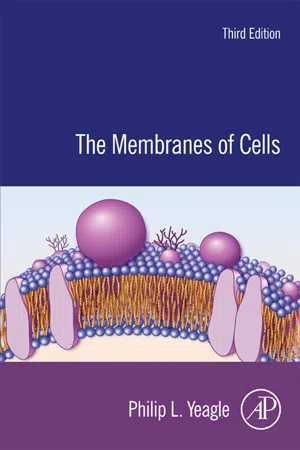Biological Sciences
Enzyme-Linked Receptors
Enzyme-linked receptors are a type of cell surface receptor that possess intrinsic enzymatic activity. Upon binding of a ligand, these receptors undergo a conformational change, leading to activation of their enzymatic function. This activation triggers a cascade of intracellular signaling events, ultimately influencing various cellular processes such as growth, differentiation, and metabolism.
Written by Perlego with AI-assistance
Related key terms
Related key terms
1 of 4
Related key terms
1 of 3
5 Key excerpts on "Enzyme-Linked Receptors"
- eBook - ePub
Medicinal Chemistry
An Introduction
- Gareth Thomas(Author)
- 2011(Publication Date)
- Wiley(Publisher)
8 Receptors and messengers 8.1 Introduction Receptors are specific areas of certain proteins and glycoproteins that are found either embedded in cellular membranes or in the nuclei of living cells. Any endogenous or exogenous chemical agent that binds to a receptor is known as a ligand. The general region on are ceptor where a ligand binds is known as the binding domain. The binding of a ligand to are ceptor depends on the ligand having a significant part of its stereoelectronic structure complementary to that of the receptor’s stereoelectronic structure (see section 1.3). Ligands that fulfil this requirement will bind to the receptor and may cause eitherapositive or negative biological response. For example, positive responses can result in an immediate physiological response, such as the opening of an ion channel, or lead toaseries of biochemical events that may result in the release of so-called secondary messengers (see section 8.4.2), such as cyclic adenosine monophosphate (cAMP). These secondary messengers promote a sequence of biochemical events that result in an appropriate physiological response (Fig. 8.1). Alternatively, the binding of the ligand to the receptor may prevent a physiological response by either initiating the inhibition of an associated series of biological events (see section 8.4.2) or simply preventing the normal endogenous ligand from binding to a receptor. For example, β-blockers such as propranolol act by blocking the β-receptors for adrenaline. In all relevant cases, the mechanism by which any message carried by the ligand is translated through the receptor system into a tissue response is known as signal transduction. Figure 8.1 A schematic representation of some of the effects of ligands binding to receptors. The binding of Ligand A to the extracellular surface of the receptor results in the activation of a secondary messenger, which is followed by a cascade of biochemical events and the appropriate physiological response - eBook - ePub
- Franklyn F. Bolander(Author)
- 2004(Publication Date)
- Academic Press(Publisher)
Fig. 4-1 ).Fig. 4-1 The four major groups of integral membrane receptors: (A) Enzyme-Linked Receptors, (B) cytokine receptors, (C) G protein-coupled receptors, and (D) ligand-gated ion channels.Like the nuclear receptors, the Enzyme-Linked Receptors are also relatively simple in structure: they have an amino-terminal extracellular domain, a single transmembrane α-helix, and a carboxy-terminal intracellular domain that contains an intrinsic enzymatic activity, such as a tyrosine kinase, a serine-threonine kinase, or a guanylate cyclase. In the case of the receptor tyrosine kinase (RTK), the hormone binds to the amino terminus and induces aggregation. This brings the catalytic domains, which have low basal activity, close enough to cross-phosphorylate each other’s activation loop, resulting in full kinase activity. The serine-threonine kinase receptors are activated in a similar manner. However, activation of the membrane-bound guanylate cyclases, which synthesize 3′5′-cyclic GMP (cGMP), is less clear but appears to involve ligand-induced neutralization of an autoinhibitory domain in the cytoplasmic region.The major substrate for the RTK is itself; the phosphorylated tyrosines (pYs) attract effectors, which have special binding modules that recognize pYs. For this brief introduction, only three are mentioned: phospholipase C? (PLCγ), phophatidylinositol-3 kinase (PI3K), and docking proteins.PLCγ hydrolyzes membrane phosphoinositides to yield the soluble head group inositol 1,4,5-trisphosphate (IP3 ) and diacylglycerol (DG) (Fig. 4-2 ). The former opens calcium channels, which elevate cytoplasmic calcium concentrations. Although calcium can affect proteins directly, it more frequently acts through calmodulin (CaM), a calcium-binding protein. The CaM-dependent protein kinase, type II (CamKII), is a classic example of how CaM works. The CaMKII has an autoinhibitory domain that acts as a pseudosubstrate for both the adenosine 5’ -triphosphate (ATP) and the catalytic sites. The CaM binding site is adjacent to the autoinhibitory domain. When calcium levels rise, calcium binds CaM and exposes its protein-binding site; CaM then binds to CaMKII and prevents the autoinhibitory domain from occupying the ATP and catalytic sites, thereby activating the kinase. Many enzymes, channels, and other proteins have these CaM binding-autoinhibitory domains. The DG is also a second messenger; its best-known target is protein kinase C (PKC), also called calcium-activated, phospholipid-dependent protein kinase - eBook - ePub
- Antonio Blanco, Gustavo Blanco(Authors)
- 2017(Publication Date)
- Academic Press(Publisher)
Chapter 25 Biochemical Basis of Endocrinology (I) Receptors and Signal Transduction Abstract Cells express receptors, which can be located inside the cell or at the plasma membrane. Intracellular receptors can be in the nucleus and cytosol. They bind nonpolar or weakly polar molecules (steroid hormones, thyroid hormones, active metabolites of vitamin D, and retinoids), which can easily cross the cell plasma membrane. Once the hormone-receptor complex (HR) forms, it dimerizes and binds to specific DNA sequences (hormone responsive elements), modifying their transcription. Peroxisome proliferator activated receptor (PPAR) is a nuclear receptor that functions as a transcription factor. It regulates metabolic pathways and the cell cycle. Membrane receptors are localized on the cell surface. Upon ligand binding, these receptors undergo conformational changes that are transmitted to protein intermediates of a signal cascade system. They belong to different types: (1) G protein coupled receptors have seven transmembrane segments. G proteins are αβγ heterotrimers, which under basal conditions are inactive, bound to GDP. After binding of the ligand to the receptor, it interacts with a G protein causing the replacement of GDP for GTP, which frees the α-GTP subunit and allows it to activate downstream effectors. The βγ dimer can also act as an intermediate in the signaling process. (2) Tyrosine kinase coupled receptors (TK) consist of an extracellular segment with the ligand-binding site, one transmembrane helix, and a cytoplasmic portion containing kinase activity. Formation of the ligand receptor complex promotes dimerization of the receptor, activates its autophosphorylation and promotes the binding of cell signaling proteins. (3) Receptors associated with extrinsic TK are similar to the ones mentioned previously, but lack the catalytic site. They associate to tyrosine kinase when bound to the ligand - Gerhard Krauss(Author)
- 2014(Publication Date)
- Wiley-VCH(Publisher)
13 Membrane Receptors with Associated Tyrosine Kinase ActivitySummary
Coupling of extracellular signals to tyrosine phosphorylation in the intracellular region may occur by two mechanisms, and involves two different receptor types. First, the receptor tyrosine kinases (RTKs), which harbor an intrinsic tyrosine kinase activity in the cytoplasmic receptor domain (see Section 10.1). The ligand-binding site and the tyrosine kinase are part of one and the same protein, and ligand binding stimulates the tyrosine kinase activity on the cytoplasmic side of the receptor. The second receptor type has tyrosine kinase associated on its cytoplasmic side, and in this case the tyrosine kinase and the receptor are not localized on the same protein. The associated tyrosine kinases belong to the group of Non-RTKs (Section 10.3). In most cases, the Non-RTK is permanently associated with the receptor and is activated as a consequence of ligand binding. Stimulation of the associated tyrosine kinase is then the starting point for transduction of the signal into the interior of the cell. In many cases, mechanisms described in previous chapters are used for further signal transmission. Four members of this receptor type will be presented in the following, namely the cytokine receptors type I and II, the immunoreceptors, and the integrins.13.1 Cytokines and Cytokine Receptors
Summary
Cytokines are a group of secreted signaling proteins that control the proliferation, differentiation and function of cells of the immune and hematopoietic systems, and they are also involved in the processes of inflammation. Often, signaling through cytokines is coupled to cell–cell interactions. Medically important cytokines include the interleukins (IL), erythropoietin (EPO), growth hormone (GH) and the interferons (IFNs). The receptors of cytokines are single-pass transmembrane proteins with distinct ligand-binding modules on the extracellular domain. The cytoplasmic domain has non-RTKs associated that become activated upon ligand binding and function as immediate downstream effectors. All cytokine receptors function as dimers or higher oligomers, and bind one or more ligands via multivalent interactions on the extracellular domain. Most cytokine receptors are composed of different types of subunit that have specialized functions in ligand binding and tyrosine kinase activation. Ligand binding to the cytokine receptor triggers an activation of the associated tyrosine kinase via a structural reorganization of the receptor oligomer. Transmission of the signal to the downstream effectors includes autophosphorylation of the associated tyrosine kinase, Tyr-phosphorylation of the receptor subunits, and the binding and phosphorylation of effector proteins.- eBook - ePub
- Philip L. Yeagle(Author)
- 2016(Publication Date)
- Academic Press(Publisher)
Chapter 15Membrane Receptors
Abstract
The membranes of cells, in particular the plasma membrane of cells, contain membrane proteins that are dedicated to provide communication between the outside and the inside of the cell. This is the process called signal transduction. Among many such receptors, several are introduced in this chapter including receptors that function by receptor-mediated endocytosis, receptor tyrosine kinases, ligand-gated ion channels, adhesion receptors, and G-protein coupled receptors. Low-density lipoprotein enters cells through receptor-mediated endocytosis, as does transferrin. The insulin receptor is a tyrosine kinase. The kinase activity is activated by insulin binding to the receptor. The nicotinic acetylcholine receptor is a ligand-gated ion channel that opens in response to binding acetylcholine. Integrins are members of the family of adhesion receptors, that both signal and mediate attachment to the extracellular matrix. A large family of receptors mediates signals through G proteins, the G-protein coupled receptors. Both rhodopsin and the β-adrenergic receptor mediate signaling through G proteins.Keywords
LDL receptor; transferrin receptor; insulin receptor; nicotinic acetylcholine receptor; integrin; guanylyl cyclase receptors; G-protein coupled receptor; rhodopsinThe plasma membranes of cells separate the inside of the cells from the outside of the cells. The communication that must occur between the environment surrounding the cell and the interior of the cell must be mediated by the plasma membrane. The communication may be in response to extracellular signals from the immediate environment or from the organism as a whole.The process whereby signals external to the cell alter intracellular behavior is called signal transduction. The signals can be hormones or other molecular species that reach the cell surface, often from other parts of the same organism. In one specialized kind of communication, the signal is a photon of light.
Index pages curate the most relevant extracts from our library of academic textbooks. They’ve been created using an in-house natural language model (NLM), each adding context and meaning to key research topics.
Explore more topic indexes
Explore more topic indexes
1 of 6
Explore more topic indexes
1 of 4




